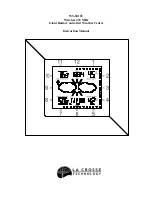
Open Controller
Introduction/Theory of Operation
3.1-7
Specifically, the logic high levels should be between 4.8 and 5.0 V, and the logic low levels should be
between 0 and 0.2 V. No other intermediate levels should be observed, and the rise and fall times
should be <30 ns.
The low-order address lines (A0-A7) and the data lines (D0-D7) should be toggling at a high rate,
i.e., you should set your oscilloscope sweep to 1 us/div. or faster to observe individual pulses. High
speed CMOS transitions should also be observed on the
µ
P control lines.
On the
µ
P the lines XIRQ (U0101-30), MODA LIR (U0101-77), MODB VSTPY (U0101-76) and
RESET (U0101-75) should be high at all times during normal operation. Whenever a data or
address line becomes open or shorted to an adjacent line, a common symptom is that the RESET
line goes low periodically, with the period being in the order of 20 msecs. In the case of shorted lines
you may also detect the line periodically at an intermediate level, i.e. around 2.5 V when 2 shorted
lines attempt to drive to opposite rails.
The MODA LIR (U0101-77) and MODB VSTPY (U0101-76) inputs to the
µ
P must be at a logic 1 for
it to start executing correctly. After the
µ
P starts execution it will periodically pulse these lines to
determine the desired operating mode. While the Central Processing Unit (CPU) is running, MODA
LIR is an open-drain CMOS output which goes low whenever the
µ
P begins a new instruction (an
instruction typically requires 2-4 external bus cycles, or memory fetches).
However, since it is an open-drain output, the waveform rise assumes an exponential shape similar
to an RC circuit.
There are eight analogue to digital converter ports (A/D) on U0101. They are labelled within the
device block as PE0-PE7. These lines sense the voltage level ranging from 0 to 5 V of the input line
and convert that level to a number ranging from 0 to 255 which can be read by the software to take
appropriate action.
For example, U0101-46 is the battery voltage detect line. R0641 and R0642 form a resistor divider
on SWB+. With 30K and 10K and a voltage range of 11 V to 17 V, that A/D port would see 2.74 V to
4.24 V which would then be converted to ~140 to 217 respectively.
U0101-51 is the high reference voltage for the A/D ports on the
µ
P. Resistor R0106 and capacitor
C0106 filter the +5 V reference. If this voltage is lower than +5 V the A/D readings will be incorrect.
Likewise U0101-50 is the low reference for the A/D ports. This line is normally tied to ground. If this
line is not connected to ground, the A/D readings will be incorrect.
Capacitors C0104, C0105, C0113, C0114 serve to filter out any AC noise which may ride on +5V at
U0101.
Input IRQ (U101-61) generates an interrupt, if either HOOK RSS (J0101-3) is higher than 6V (SBEP
communication) and turns Q0106 on via Q0105, Q0104, or a low at the option interrupt pin (J0103-
8) turns Q0124 off and Q0125 on. The
µ
P determines the interrupt source by reading the collector of
Q0104 via U0101-6 and the collector Q0124 via U0101-7.
Содержание GM1200E
Страница 2: ...ii ...
Страница 4: ...Cautions and Warnings iv ...
Страница 6: ...Cautions and Warnings vi ...
Страница 8: ...Contents viii Detailed Service Manual ...
Страница 10: ...Table of Contents 1 ii Introduction ...
Страница 14: ...Table of Contents 2 ii Control Head Level 3 Information ...
Страница 16: ...Table of Contents 2 1 ii Introduction Theory of Operation ...
Страница 24: ...Table of Contents 2 2 ii PCB Schematic Diagram and Parts List ...
Страница 26: ...Table of Contents 3 ii UHF VHF Radio Level 3 Information ...
Страница 30: ...Table of Contents 3 1 iv Introduction Theory of Operation ...
















































